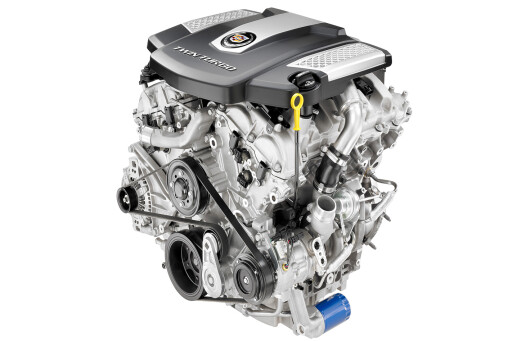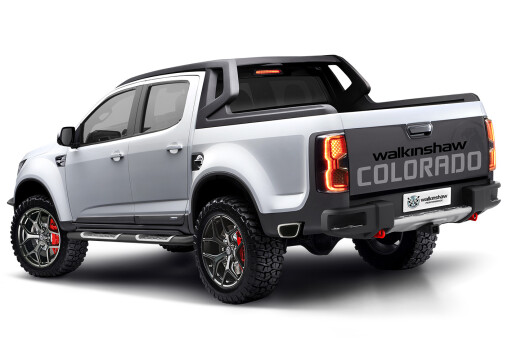
WALKINSHAW Performance is readying a 300kW-plus twin-turbo petrol V6 version of the Holden Colorado.
The top secret project – known as Wildfire, a name recently registered by the Walkinshaw Group – involves shoehorning the LF3 3.6-litre twin-turbo V6 used in the Cadillac CTS V-Sport under the bonnet of the Colorado dual-cab 4x4.
It arrives as brands as diverse as Ford, Toyota and Mercedes-Benz look to expand the reach – and performance – of their top-end utes.
For the Walkinshaw Group – which also produces HSVs for Holden – the Wildfire is the first step towards a new breed of high performance road cars. However, the company is tight-lipped for now.
“We make a point of not discussing future models or business strategy,” Walkinshaw Performance general manager, Gary Beer, said. “There are many projects we are exploring, but until we have a specific vehicle solution in place we won’t be adding to the speculation.”
 The high-tech, blown V6 in the Wildfire belts out up 313kW and 583Nm in the Cadillac CTS V-Sport, which should be enough to propel the workhorse ute to 100km/h in about 5.5 seconds – assuming it can get the grunt to the gravel.
The high-tech, blown V6 in the Wildfire belts out up 313kW and 583Nm in the Cadillac CTS V-Sport, which should be enough to propel the workhorse ute to 100km/h in about 5.5 seconds – assuming it can get the grunt to the gravel.
While the Wildfire project is yet to get the green light, engineers have already trialled the engine locally and are working through numerous challenges, many of which involve developing software to get the Cadillac engine ‘talking’ to the rest of the Colorado’s electrical architecture.
The design element is more straightforward and, despite the project being in its infancy, has already been envisioned. Expect a blacked-out bonnet bulge with additional venting to cool the engine utilised by GM’s luxury brand, Cadillac.
2017 Holden Colorado Storm arrives
The matte black theme will continue throughout, while designers are also expected to utilise HSV’s skills in altering body panels. The Wildfire could get flared front wheel arches to house larger, more aggressive rubber.
Dampers are a key focus for the Wildfire, with the aim of better tying it down and utilising more aggressive rubber. Also expect engineers to play with reduced spring rates, with the view to lowering the load capacity – forget the classic one-tonner – and instead adding more control and suppleness; working over a narrower load band allows finer tuning for the sporty focus.
Also expect sizeable AP Racing brakes, something that would leverage the Walkinshaw Racing relationship. However, despite the substantial suspension development, engineers are committed to ensuring the Wildfire maintains the Colorado’s off-road nous.
 If it’s given the green light – engineers are quietly optimistic – the Wildfire would have a seriously broad remit and be one of the few cars to undergo extensive development work on racetracks and dirt trails. But it’s what’s beneath the skin that promises to separate the Wildfire from the emerging breed of go-fast utes.
If it’s given the green light – engineers are quietly optimistic – the Wildfire would have a seriously broad remit and be one of the few cars to undergo extensive development work on racetracks and dirt trails. But it’s what’s beneath the skin that promises to separate the Wildfire from the emerging breed of go-fast utes.
Whereas the ute market is almost exclusively diesel, the twin-turbo petrol V6 ups the performance ante big time, all but guaranteeing a monstrous leap over rivals, the most serious of which is shaping up to be the Ford Ranger Raptor.
While Ford announced it is deep in development of the fettled Ranger, it has not confirmed what engine will be used. Like the rest of the Ranger line-up in Australia, the Raptor will utilise a diesel powertrain for Australia.
Engineers are currently working on a new 2.0-litre four-cylinder turbo-diesel, which could outpunch the 147kW/470Nm 3.2-litre five-cylinder in the current Ranger. However, the bulk of the focus will be on major suspension modifications aimed at giving it some Trophy Truck off-road toughness.
It’s that dual personality that is shaping the new breed of hot utes. HSV is also working on a version of the Colorado; although, that car will use a diesel engine. Toyota, too, is looking to capitalise on interest in its TRD Hilux with a fully fledged model rather than the dealer pack that was a toe in the water.
Engineers are currently working on a more serious iteration of the TRD. However, don’t expect any changes to the modest 2.8-litre four-cylinder diesel, with 130kW set to be the limit for the medium term. Instead the efforts will be on styling and off-road capability; think big wheels and suspension, along with additional underbody protection.
Then, of course, there’s the German diesel V6s in the form of Merc X-Class and Volkswagen Amarok, which both put out 550Nm in current form.

COMMENTS